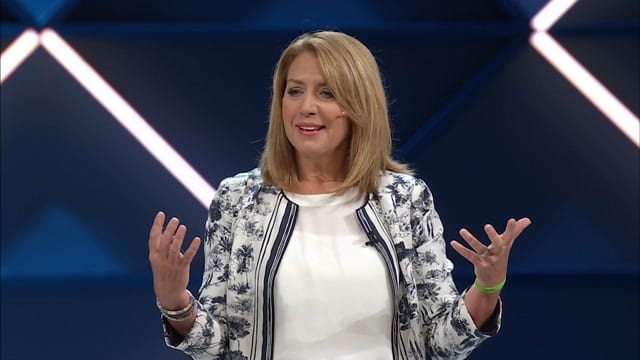
As a general rule, people tend to do best what they enjoy most.

As a general rule, people tend to do best what they enjoy most.

Attorney Bryan Stevenson explores the necessity of hope when working to bring about societal change.

The key to business isn’t being smarter or wealthier, it’s being able to connect to people and relate to them.

Creativity expert Fredrik Härén discusses the mindset cultivated by truly creative people.

If you really believed God had your back, you would stop putting on a front.

When Luis Pinto and his wife Carol first started attending “La Cumbre” (Summit) in Guatemala, they realized The Global Leadership Summit could have countrywide impact. Today, Luis spearheads The Global Leadership Summit movement in Central America.
 The first time I attended the Summit was in 2008 when I was one of the youth pastors at my church. One of the pastors invited me, but I didn’t really want to go.
The first time I attended the Summit was in 2008 when I was one of the youth pastors at my church. One of the pastors invited me, but I didn’t really want to go.
But the Summit turned out to be a transformational event for me.
I didn’t know that three years later I was going to be called by my pastor to help with the expansion of the GLS in Guatemala. In 2014, I was called by Willow Creek Association to do the same thing in Central America. Six months later, it was the Caribbean. A year later, it was all of Central America. So, I am 100 percent involved in the GLS and Willow Creek Association.
The GLS has helped me understand what my role is — why I am here, and that God is calling me to do something significant for my country and my people.
Today, the GLS is expanding across multiple audiences beyond the church. Right now we have 10 Summit sites in Guatemala. We have attendance from all sectors of society. Sixty-five percent of the attendees last year came from the marketplace. The remaining 35 percent was divided between the church, the government, education and non-profits. It has a very significant impact in our society. What we’re seeing unfold is unbelievable! Here are just a few highlights, and the 6 reasons the Summit works in Latin America:
 We started to work with youth in Guatemala in 2012. The idea was to involve them in doing something significant for their lives and for our country.
We started to work with youth in Guatemala in 2012. The idea was to involve them in doing something significant for their lives and for our country.
That first year, we brought the franchise owner of McDonald’s in Central America, and we had an extraordinary event for youth. We didn’t want to have just a “nice” event and “nice” talks, and nothing else. We know if we don’t do something in 72 hours to follow up, then the GLS becomes another nice event. That’s it.
So, at every Summit event, we talk about action. What step will we take next?
At that first Summit for the youth, we invited youth organizations that were doing significant things for society. We collaborated with International Justice Mission, Compassion International and others to bring in volunteers in different organizations that support feeding the hungry, or people who were homeless or suffering from abuse.
This youth movement has been growing so fast and in so many ways. Young people started this movement, and now I can see them doing important things for our society and nation.
 Corruption and violence is very typical in our country. This past August, seven people, including two children, were killed and 12 injured in a gang shooting in a hospital in Guatemala City. Gunmen burst into the hospital to rescue a jailed gang member who had been transferred there for a medical appointment. The shooters were members of the Salvatrucha gang, one of the most notorious bands terrorizing Central America. When it was over, two prison guards, two hospital workers, two children and another adult were killed.
Corruption and violence is very typical in our country. This past August, seven people, including two children, were killed and 12 injured in a gang shooting in a hospital in Guatemala City. Gunmen burst into the hospital to rescue a jailed gang member who had been transferred there for a medical appointment. The shooters were members of the Salvatrucha gang, one of the most notorious bands terrorizing Central America. When it was over, two prison guards, two hospital workers, two children and another adult were killed.
That is what is happening in our country. Good people are doing nothing because they are afraid.
Seven innocent people died because we did nothing.
Gary Haugen spoke at the Summit this year. He is the founder and president of International Justice Mission, which is an international human rights agency that rescues victims of violence, sexual exploitation, slavery and oppression.
Gary said we don’t need to be afraid to do something that God is calling us to do. We need the courage of God in our hearts.
After that presentation, I thought that we need to stop being afraid and stand up. We must stand in front of the giants of corruption and violence and do something.
The president of Guatemala’s Supreme Court and some of the judges also attended. They are in the midst of dealing with the problems in our country. When they come to the Summit and listen, they are transformed.
 In the Latin American culture, especially in Mexico and Central America, women are not supposed to take any role in leadership. Only men. We want to break that. We want to leverage women’s leadership and see more women taking leadership positions in all the fields.
In the Latin American culture, especially in Mexico and Central America, women are not supposed to take any role in leadership. Only men. We want to break that. We want to leverage women’s leadership and see more women taking leadership positions in all the fields.
I was at an event with my wife and I met with about10 women who were planning to start a movement against human trafficking in Guatemala. I was shocked when I heard them talking about their plans. They are not afraid. They have strength and creativity. All of them were under 30 years old. I can see the hunger, the strength, the passion and energy they have.
Next year we’re planning a big Summit event for 400, maybe 500 women.
 I can see God using the Summit and moving across Latin America. For example, our friends in El Salvador invited the guerrillas and the army to sit down at the same table. This is a country that has been dealing with internal war for many years.
I can see God using the Summit and moving across Latin America. For example, our friends in El Salvador invited the guerrillas and the army to sit down at the same table. This is a country that has been dealing with internal war for many years.
The pastor at the GLS worried because both the principle leaders of the guerrillas and the army accepted the invitation and would be together under the same roof. So, he created a lunch event and asked me to talk for an hour. I talked about how we don’t want those who come to the GLS to be in combat. We want them to be in collaboration.
Both sides that day were angry. They wouldn’t answer to each other. They just answered to me. After 30 minutes or so, I started talking about what Jesus said: “Father, let them be one as you and I are one.” And the guerrilla leader said, “We need this in our country. We don’t need to continue fighting.”
So, the members of the army and the guerrillas shook hands and began a conversation. They even took a picture together at the end. The most wonderful thing was they continued their conversations a few months later. They continued in the same room watching the GLS presentations. This is amazing.
 At one of the Summits, Blake Mycoskie of Tom’s Shoes spoke about how if you buy a pair of shoes from Tom’s Shoes, a child without shoes in another country will get a pair. That presentation had an impact on a big businessman here in Guatemala City. He owns a company that sells eggs, and he asked us what he could do.
At one of the Summits, Blake Mycoskie of Tom’s Shoes spoke about how if you buy a pair of shoes from Tom’s Shoes, a child without shoes in another country will get a pair. That presentation had an impact on a big businessman here in Guatemala City. He owns a company that sells eggs, and he asked us what he could do.
He said, “What if I give two eggs for every box of eggs people buy?” He did that and sales increased 15 percent in the first month. Second month, it increased by 30 percent. By the end of 6 months, he gave a significant check for poor children in our country.
That is the power of the Lord in your company.
We are preparing to have 120 GLS events across Latin America. Seven years ago, we only hosted six events. To reach new audiences, we have developed a program that we call GLSE, or GLS Extended. The GLS is only two days—then what? What happens the other 363 days?
With the GLSE program, the idea is to establish small events in different places with different segments throughout the year so we can keep people connected to the GLS. We have 80-90 different talks selected from over the years, as well as books and training materials. We can divide all that information and use it for year-round training.
Five or six years ago we started this in Guatemala City. Then it was Mexico and South America. Now other parts of the world like Africa and Asia are pursuing the same model.
Of course, one of the challenges we have is that we need more people working with us to sustain that growth. Getting funds to pay the staff has been one of the most significant challenges we have had. We are not superheroes. We can’t do it all. If we don’t pay attention and do nothing, we could lose our momentum.
It is working here in Guatemala because there is such a need for leaders. We have a lack of leaders. Everyone is focused on doing their own things rather than seeing a grander vision for our country.
That’s why the GLS works. It challenges people. The GLS moves their hearts. They move out of their comfort zone—and they transform their communities.

It’s time for performance reviews. And, if we’re honest, the internal dialogue in our heads goes something like this:
“The system is broken. The ratings are either forced or all fives. Reviews require a whole bunch of time we don’t have, and stress and anxiety we don’t need. And for what? We’re still not getting the information we need to know how we’re doing, or what to work on next.”
It seems as if every organization is redesigning or reimagining their performance management system. If we can fix the system, or fix the managers, then we’ll have fixed performance—then you’ll get better, more meaningful feedback.
But what if the power to get better feedback, and to drive your own learning and your career actually sat with you?
We believe it does.
Whatever the official system and structure, whoever your manager may be, you have the ability to manage your own performance. How might you figure out what is working well—what you should continue to do? What do others secretly (or not so secretly) wish you would do differently? How are you tracking against goals and expectations? And what are those expectations?
 Manage your performance by managing your feedback diet.
Manage your performance by managing your feedback diet. Any athlete knows that to function at peak performance they need to feed their body the nutrients it needs. A healthy diet builds muscle, extends stamina and aids recovery time.
The same is true for our professional performance. A healthy variety of feedback can fuel our learning and growth. So often we hear individuals and teams complain that they want more feedback—they are hungry for it.
If we’re going to accelerate our learning, we actually need three different kinds of feedback. Each serves different purposes, so thinking about what you need right now—this week or in the midst of this new project—is critical.
Appreciation lets us know that our efforts are seen. That they matter to someone. It also helps us understand what we are doing that is working well. Appreciation impacts motivation and engagement—it is a hedge against burnout, and helps us go that extra mile. If you are feeling short on appreciation, letting others know is actually helpful: “It’s a rough week for me, guys. If there’s anything I’m doing right, I could use the encouragement.” Or “What’s one thing I’m doing that’s working well, that you want to be sure I keep doing?”
Coaching is the engine for learning, and includes anything that helps you improve—suggestions, ideas, requests, correction, even role modeling. People can be hesitant to offer coaching—they don’t want you to feel criticized. But if you are looking to drive your own performance, there’s no more powerful tool than requesting coaching from those around you: your peers, your team members, even your clients or customers. Invite others’ thoughts by asking, “What’s one thing I could change that would make a difference to you?”
Evaluation lets us know how we’re tracking against goals and expectations. Whether it’s a new project or our career, we’re wondering whether we are “on track.” Get a regular pulse on how others think you’re doing by asking, “On a scale of 1-5, how do you think this is going?” Or “How does this compare to what you were hoping for?” Or “Can you give me a quick sense of how I’m doing?” The conversation that follows could give you the opportunity to figure out ways to course correct. It can also provide a sense of security, so you don’t need to worry or wonder.
Instead of waiting for others—or the always-imperfect performance system—to manage your career, grab the opportunity to drive your own career and learning. Here are three questions that can help you assess your feedback diet, figure out what kind of feedback you need more of right now and who you might reach out to for input:
1) Which kind of feedback (appreciation, coaching, evaluation) do I need more of right now?
2) Who might be able to provide that type of feedback? Hint: it’s not always your direct supervisor. Others you work with regularly are a rich source of ideas for what you could change to make it easier for them to work with you.
3) How might I ask them, and let them know which kind of feedback I’m looking for? Whether it’s sending a quick email, adding it to the agenda for your next 1:1, or going for a walk with that other person, asking for the type of feedback you want is the first step to managing your own performance.
The good news is you don’t need to wait around for the perfect mentor to show up or the perfect performance management system to be put in place. If you are determined to learn, nobody can stop you.

Interest without purpose is nearly impossible to sustain for a lifetime.

In this excerpt, Wiseman shares that the secret to rookie smarts is having a good stretch. By stretch she means the ability to expand to the level of challenge.

In this excerpt, Wiseman shares that the secret to rookie smarts is having a good stretch. By stretch she means the ability to expand to the level of challenge.
“We welcome and encourage comments on this site. There may be some instances where comments will need to be edited or removed, such as:
If you have any questions on the commenting policy, please let us know at heretoserve@globalleadership.org”
Recent Comments